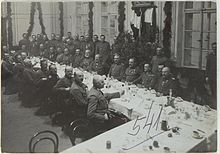Southern Army (German Empire)
The South Army / Army High Command South (AOK South) was a large association and the associated command authority of the German army during the First World War (1914-1918). It comprised several army or reserve corps as well as numerous special troops.
history
|

To support the Austro-Hungarian armed forces on the Eastern Front , German troops were relocated to the Hungarian Carpathians in early 1915 . The command of these troops was incumbent on the General Command of the II. Army Corps , which was converted for this purpose on January 11, 1915 into a regular Army High Command called "South". The subordinate troops were thus combined as the Southern Army under General of the Infantry Alexander von Linsingen and inserted at the seam of two Austro-Hungarian armies. The eastern Austro-Hungarian army under General Karl von Pflanzer-Baltin covered the southern bank of the Dniester and in Bukovina; the western Austro-Hungarian 3rd Army under General Boroević tried several times in vain to relieve the Przemyśl fortress. In between, the Southern Army was divided into several independently operating combat groups due to the separate mountain pass roads:
- the Corps "Gerok" with the 48th Reserve Division , the Austro-Hungarian 19th Infantry Division and the 12th Landsturm Brigade operated on the east wing,
- the Imperial and Royal Corps "Hofmann" with the German 1st Division , the Imperial and Royal 55th Infantry Division and the 131st Landsturm Brigade stood in the middle and
- the 3rd Guards Division under General von Marschall formed the left wing.
In mid-February, the southern army received the Austro-Hungarian 2nd Army under Eduard von Böhm-Ermolli as a new neighbor on the left wing and in April 1915 captured the Zwinin and Ostry. With the general advance of the Carpathian Front, the Southern Army advanced through the Latorca Valley to the Stryj in May . At this point in time the southern army on the left wing was subordinated to the Austro-Hungarian Corps "Szurmay" when advancing towards Drohobycz , the 1st Division and the 3rd Guard Division were now combined to form the Corps "Bothmer" and reached Stryj .
Another reorganization took place on July 8, 1915. The Army High Command South took over command of the newly formed Bug Army in Lemberg, while the previous troops, tasks and designations were taken over by the General Command of the II. Bavarian Reserve Corps , and General of the Infantry Felix von Bothmer was appointed as the new Commander-in-Chief . The Southern Army demonstrated a high degree of stability against the Russian attacks in the summer of 1916 during the Brusilov offensive and in the summer of 1917 during the Kerensky offensive . In the summer of 1917 the southern army in the Brzezany area was subordinate to:
- kuk XXV. Corps (General Peter von Hofmann) with 54th and 55th Infantry Divisions
- XXV. Reserve Corps (General der Artillerie Konstanz von Heineccius ) with 15th Reserve Division , 241st Division and 4th Replacement Division
- XXVII. Reserve Corps (General of the Cavalry Hans Krug von Nidda ) with 24th and 53rd Reserve Divisions and the Austro-Hungarian 38th Honved Division.
When the end of the war on the Eastern Front became apparent, the army was disbanded as a major unit on January 25, 1918 .
The headquarters of the Southern Army were located in Munkacz (from January 11, 1915), Stryj (from June 5, 1915), Brzezany (from September 4, 1915), Chodorow (from November 15, 1916) and Czortkow (from August 4, 1917 ).
→ Main article: Army (German Empire)
literature
- Hermann Cron: History of the German Army in the World War 1914–1918. Military publisher Karl Siegismund. Berlin 1937. ( History of the Royal Prussian Army and the German Imperial Army 5).
Web links
- The highest command posts in the army. on www.deutsche-kriegsgeschichte.de (as of May 6, 2010)
